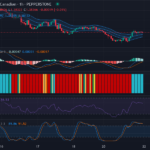
US Dollar vs. Canadian Dollar: Delicate Balance Amid Lateral Movement – 22/04/2025
Tháng 4 21, 2025USDCAD: Sideways Market Prediction with Neutral Sentiment
Tháng 4 22, 2025USDJPY Sentiment Shift Analysis: Long Position Changes
USDJPY Technical Data Point: 1% Increase in Long Positions
Recent data indicates a 1% increase in long positions for the USDJPY currency pair. This change in sentiment suggests a growing interest among traders betting on the Japanese Yen weakening against the US Dollar. Such movements in positioning can often highlight broader market expectations of price dynamics. The increased long positions may reflect traders’ anticipation of USDJPY strength, potentially driven by macroeconomic factors or Central Bank policy stances not detailed here. As the market absorbs this shift, it will be crucial for traders to monitor any impactful economic announcements or interest rate changes that could affect the USDJPY trajectory.
Correlation Between USDJPY Sentiment and Price Action
Understanding the correlation between sentiment shifts and price action is essential for effective forex analysis. The 1% increase in long positions for USDJPY could indicate a potential price movement in a specific direction, mirroring traders’ expectations of fluctuations in exchange rates. The currency pair’s price action often reflects the collective sentiment, though it might also face periods of consolidation or sideways movement influenced by market psychology and fundamental news not included in this analysis. It is during such times of uncertainty or sideways trends that trader greed can drive significant volatility, as participants in the forex market vie to capitalize on anticipated movements, emphasizing the need for precision in timing and strategies. As sentiment continues to evolve, traders may find themselves recalibrating their positions based on ongoing developments around USDJPY.
USDJPY Price Prediction Based on Sentiment Analysis
USDJPY Statistical Confidence Levels and Targets
The USDJPY pair, widely monitored in the forex market, reflects market dynamics characterized by investor sentiment, which often influences price movement. Sentiment analysis reveals underlying patterns that traders exploit to predict currency trends.
Greed, a critical sentiment indicator, often leads to heightened market activity and potential price volatility. When analyzing USDJPY, this sentiment can be pivotal in shaping market directions as traders react to shifts in economic forecasts and geopolitical developments.
Market scenarios with strong sentiment trends, such as greed, can lead to prolonged periods of sideways movement, reflecting uncertainty as traders await significant economic data releases or geopolitical news. This pattern in the USDJPY demonstrates the market’s ambivalence, often leading to consolidation phases and diminishing trading volumes.
The correlation between sentiment analysis and USDJPY pricing helps in crafting strategic entry and exit points. Understanding these factors enhances clarity in forecasting targets, supported by statistical confidence. However, the temporal and dynamic nature of sentiment necessitates continuous analysis, as investor behavior can shift rapidly, altering potential targets.
By leveraging sentiment analysis, traders can develop a more nuanced view of the USDJPY currency pair, aligning their strategies with market sentiment to optimize their trading positions amidst shifting confidence levels. This approach offers the potential to identify sideways trends and capitalize on greed-driven market dynamics.
USDJPY Trading Strategy Recommendations
In the current forex landscape, the USD/JPY currency pair presents unique opportunities influenced by prevailing market conditions. Traders keen on engaging with this pair should be attuned to its behavior, especially considering potential sideways movements and psychological factors such as greed.
The USD/JPY often exhibits a sideways trend, which can be advantageous for traders utilizing range-bound strategies. This involves identifying strong support and resistance levels, allowing for buy positions near the support while considering sell positions close to resistance. Such strategies capitalize on the predictable oscillations within defined boundaries, minimizing risk and maximizing potential return.
However, market participants must remain vigilant against the influence of greed. This psychological factor can lead to overtrading and the pursuit of high-risk moves far outside of established trading plans. Practicing disciplined risk management is essential. Implementing stop-loss orders and maintaining a clear profit-taking strategy can safeguard against the emotional impulse to chase unrealistic gains.
Given the dynamic nature of forex analysis, particularly with USD/JPY, technical indicators are invaluable. Techniques such as RSI (Relative Strength Index) and moving averages can help determine entry and exit points, reinforcing decisions made from observing the broader trend. When the market is in a confirmed sideways pattern, these indicators provide additional layers of robust analysis, enhancing trading precision.
Ultimately, navigating the USD/JPY landscape requires a combination of technical skill, strategic planning, and emotional control. By aligning your trading strategy with these factors, capitalizing on the currency pair’s tendencies while keeping greed in check can lead to successful outcomes in your forex analysis journey.
